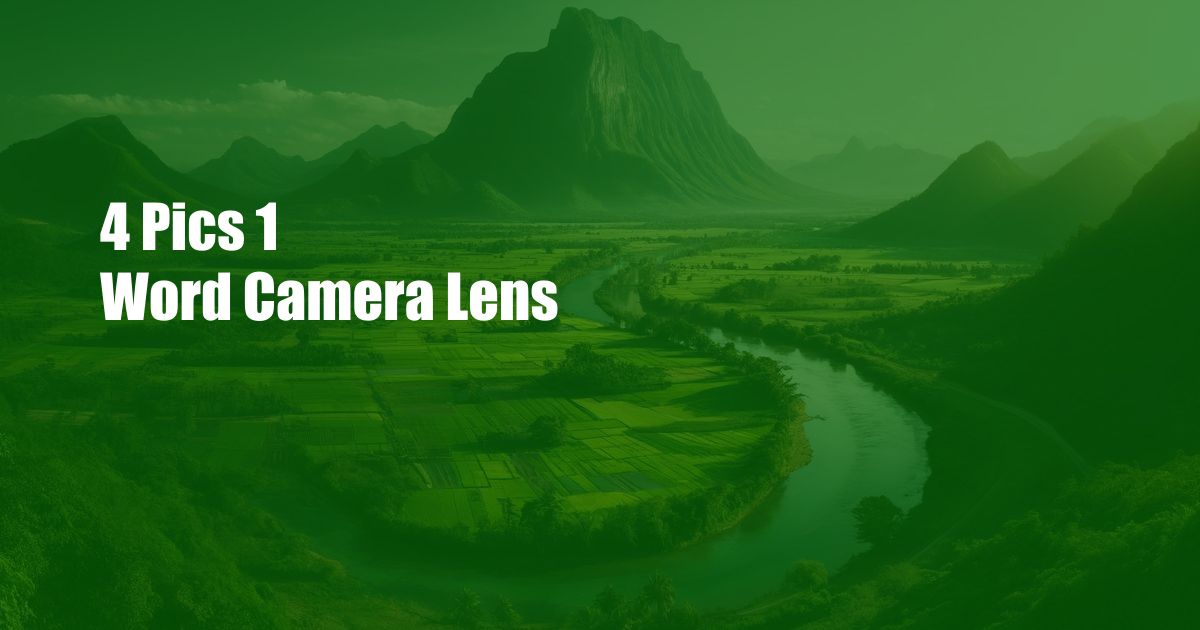
4 Pics 1 Word Camera Lens: A Guide to Understanding Lenses and Improving Your Photography
Photography is an art form that allows us to capture moments in time and share them with the world. Lenses are an essential part of any camera, and they play a crucial role in determining the quality and composition of your images. In this blog post, we’ll be discussing the different types of camera lenses, their uses, and how to choose the right lens for your photography needs.
We’ll also provide some tips and expert advice on how to use your lenses effectively to improve your photography skills. So whether you’re a beginner or a seasoned pro, this blog post has something for you. Let’s get started!
Types of Camera Lenses
There are many different types of camera lenses available, each with its own unique characteristics and uses. The most common types of lenses include:
- Wide-angle lenses: Wide-angle lenses have a short focal length, which allows them to capture a wide field of view. They’re often used for landscape photography, architecture photography, and group shots.
- Normal lenses: Normal lenses have a focal length that is similar to the human eye, which gives them a natural perspective. They’re often used for portrait photography, street photography, and photojournalism.
- Telephoto lenses: Telephoto lenses have a long focal length, which allows them to magnify distant objects. They’re often used for wildlife photography, sports photography, and portraits.
- Macro lenses: Macro lenses are designed for close-up photography, allowing you to capture the smallest details of your subject. They’re often used for nature photography, product photography, and scientific photography.
Choosing the Right Lens
Choosing the right lens for your photography needs is important. Here are a few things to consider:
- The type of photography you’ll be doing: Different types of photography require different types of lenses. For example, if you’re planning on doing a lot of landscape photography, you’ll need a wide-angle lens. If you’re planning on doing a lot of portrait photography, you’ll need a normal or telephoto lens.
- The camera you’re using: Not all lenses are compatible with all cameras. Make sure that you choose a lens that is specifically designed for your camera.
- Your budget: Lenses can range in price from a few hundred dollars to several thousand dollars. Determine how much you’re willing to spend on a lens before you start shopping.
Tips for Using Lenses Effectively
Once you’ve chosen the right lens, it’s important to know how to use it effectively. Here are a few tips:
- Understand your lens’s focal length: The focal length of your lens determines how much of the scene you’ll be able to capture. A shorter focal length will give you a wider field of view, while a longer focal length will give you a narrower field of view.
- Use the right aperture: The aperture of your lens controls the amount of light that enters the camera. A larger aperture will let in more light, while a smaller aperture will let in less light. A larger aperture will also create a shallower depth of field, while a smaller aperture will create a deeper depth of field.
- Experiment with different angles: Don’t be afraid to experiment with different angles when taking photos. Sometimes, the best shot can be found by getting down on your knees or shooting from above.
Frequently Asked Questions
Here are the answers to some of the most frequently asked questions about camera lenses:
- Q: What is the difference between a zoom lens and a prime lens?
- A: A zoom lens has a variable focal length, while a prime lens has a fixed focal length. Zoom lenses are more versatile, but prime lenses are often sharper and faster.
- Q: What is the best lens for beginners?
- A: A 50mm prime lens is a great lens for beginners. It’s versatile enough to be used for a wide range of photography, and it’s relatively affordable.
- Q: How often should I clean my lenses?
- A: You should clean your lenses whenever they get dirty. A dirty lens can cause your photos to be blurry or hazy.
Conclusion
Now that you know more about camera lenses, you’re ready to start taking better photos. Experiment with different lenses, and see what kind of results you can get. With a little practice, you’ll be able to master the art of lens photography and take your photography to the next level.
Are you interested in learning more about camera lenses and photography? Check out the rest of our blog for more tips and advice.

 Hogki.com Trusted Information and Education News Media
Hogki.com Trusted Information and Education News Media